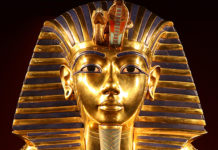The Nasca lines of southern Peru acted as a form of materialized ideology. These lines are made up of over 1,000 figures, covering about 400 square miles of desert, and incorporating depictions of animals as well as religious and geometric motifs. Indeed, the iconography featured in these large geoglyphs matches the iconography used on polychrome ceramics from that period, and changes in the ceramic styles mirror changes in the motifs of the Nasca lines.
Nasca Monuments as Ideology
As materialization of ideology also occurs through monument-building, the Nasca lines exemplify large-scale materialization of ideology. Thus, this institutionalization of monument building by elites in relation to religion and meteorological phenomenon allowed for these elites to gain status in the Nasca world for their association with rain and agricultural fertility.
Institutionalizing Religion in the Nasca Civilization
That is, by associating themselves with the supernatural world in terms of religious practices and spirituality, elites maintained their superior role in society. By creating and institutionalizing religion in Nasca through materialization, elites were seen as important corporate figures, responsible for the belief and practices of the civilization. It is evident that this use of ideology was crucial to emerging elites in Nasca as they struggled to gain authority and prestige in the face of competition and resource unavailability.
However, during the Late Intermediate Period (A.D. 1000-1476), there was a shift in sociopolitical and economic organization in Nasca. While elites had previously been associated predominately with Cahuachi, during this later period they were present at every level of society.
This was likely caused by the success of elites in materializing ideology during the Early Nasca, as they could then abandon methods of power procurement through feasting, ritual, and pottery production at Cahuachi and instead develop a lineage of power, allowing elitism to spread to every area of the civilization in the form of local elites. This clearly demonstrates the effectiveness of the materialization of ideology in generating power and lasting consequences for society.
The Model of the Development of Social Complexity in the Nasca Civilization
The use of materialized ideology in the Early Nasca through monumentalism, polychrome ceramics, and ritual and ceremony enabled chiefly wealth and prestige. Ideologically charged material culture ranges from small-scale attempts like symbolic objects all the way to massive monumental architecture serving to associate communities with a place and foster group cohesion and strong political affiliations. Cahuachi, the production of polychrome ceramics, and the large Nasca lines all serve of examples of how ideology and belief is turned into tangible culture in order to generate power and prestige.








